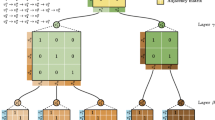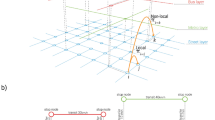Abstract—
Many aspects of the functioning of the transport network and its impact on the socioeconomic development of a territory significantly depend on its morphology. In particular, the morphological features of the network underlie the network effects, which can lead to significant changes in transport costs (both downward and upward) with minor modifications to the network. The article analyzes the factors most significant for the morphology of the intercity transport network and presents a mathematical description of the mechanisms for the realization of their influence. It is shown that the key factor is the location of network vertices in space, and a two-parameter family of models is proposed that can generate networks close to real ones, only based on information about the spatial location of their vertices. Implementation of the proposed model is demonstrated using the intercity highway network in Belarus. For this network, the optimal parameter values were selected, and it was shown that the resulting model is quite close to the original network.





Similar content being viewed by others
Notes
Precise definitions and descriptions of the terms “dendrites” and “cycles” in relation to transport networks can be found in [9].
The standard enumeration method used to minimize the function φ(a, b) consists in the two-dimensional range of arguments a and b being covered by a mesh with a cell size much smaller than the area under consideration. Then, the values of function φ are calculated at the grid nodes and the smallest of them is selected. The accuracy of this method depends on the cell size.
REFERENCES
Bugromenko, V.N., Transport v territorial’nykh sistemakh (Transport in Territorial Systems), Moscow: Nauka, 1987.
Livshits, V.N., Belousova, N.I., Bushanskii, S.P., Vasil’eva, E.M., and Guk, S.N., The dynamics of technological determinants of natural monopoly transport networks at their optimal development, Audit Fin. Anal., 2011, no. 4, pp. 138–159.
Martynenko, A.V., Wolfram Mathematica software as a universal environment for processing and analyzing geographic information, Geogr. Vestn., 2016, no. 4, pp. 129–138.
Martynenko, A.V. and Petrov, M.B., Influence of surface transportation network on accessibility (by the example of Sverdlovsk oblast), Reg. Issled., 2016, no. 2, pp. 21–30.
Panov, R.D., The evolution of the spatial structure of the world’s largest metro networks, Izv. Ross. Akad. Nauk, Ser. Geogr., 2020, no. 1, pp. 20–26.
Seliverstov, S.A., Development of indicators of transport provision, Izv. S.-Peterb. Gos. Univ. Putei Soobshch., 2015, no. 4, pp. 48–63.
Tarkhov, S.A., Analysis of topological defects of land transport network of Siberian and Far Eastern regions, Reg. Issled., 2019, no. 3, pp. 53–62.
Tarkhov, S.A., Spatial consistency of growth of high-speed railways in the world, Reg. Issled., 2016, no. 4, pp. 90–104.
Tarkhov, S.A., Evolyutsionnaya morfologiya transportnykh setei (Evolutionary Morphology of Transport Networks), Smolensk: Universum, 2006.
Aldous, D. and Shun, J., Connected spatial networks over random points and a route-length statistic, Stat. Sci., 2010, vol. 25, no. 3, pp. 275–288.
Barthélemy, M., Spatial networks, Phys. Rep., 2011, vol. 499, nos. 1–3, pp. 1–101.
Böhme, K., Toptsidou, M., Holstein, F., and Martin, D., Territorial Cooperation for the Future of Europe, Luxembourg: ESPON, 2017.
Haggett, P. and Chorley, R., Network Analysis in Geography, London: Edward Arnold, 1969.
Kansky, K., Structure of Transportation Networks: Relationships Between Network Geometry and Regional Characteristics, Chicago: Univ. of Chicago Press, 1963.
Nes, R., Design of multimodal transport networks: a hierarchical approach, PhD Thesis, Delft: Tech. Univ. Delft, 2002.
Open street map data extracts. https://www.geofabrik.de. Accessed May 10, 2020.
Xie, F. and Levinson, D., Topological evolution of surface transportation networks, Comput., Environ. Urban Syst., 2009, vol. 33, pp. 211–223.
Yerra, B. and Levinson, D., The emergence of hierarchy in transportation networks, Ann. Reg. Sci., 2005, vol. 39, no. 3, pp. 541–553.
Zhang, L. and Levinson, D., A model of the rise and fall of roads, J. Transp. Land Use, 2017, vol. 10, no. 1, pp. 337–356.
Funding
The article was prepared in accordance with the R&D Plan of Ural State University of Railway Transport (R&D topic no. АААА-А20-120042190035-7).
Author information
Authors and Affiliations
Corresponding author
Ethics declarations
The author declares no conflict of interest.
Rights and permissions
About this article
Cite this article
Martynenko, A.V. Modeling the morphology of the intercity road network. Reg. Res. Russ. 11, 9–17 (2021). https://doi.org/10.1134/S207997052101010X
Received:
Revised:
Accepted:
Published:
Issue Date:
DOI: https://doi.org/10.1134/S207997052101010X




